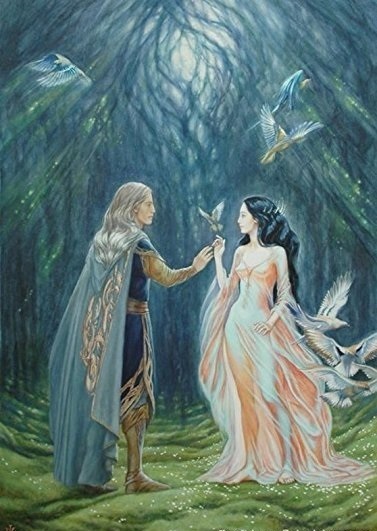What do you think?
Rate this book


321 pages, Kindle Edition
First published June 1, 2017
















And o’er the host of hell there shoneThe Lay of Leithian is definitely my favorite version of this tale and it makes me wish that Tolkien had written the entirety of The Silmarillion in verse. Can you imagine how epic (in every sense of the word) that would've been?
with a cold radiance, clear and wan,
the Silmarils, the gems of fate,
emprisoned in the crown of hate.
The Isle in Sirion they left behind;Beren and Lúthien wander until they approach Doriath and Beren steals away from Lúthien while she sleeps and goes to Angband to fulfill his quest. Before approaching Thangorodrim Lúthien and Huan once again find him and, with the help of Lúthien's elvish magic, they approach Angband in the guise of a werewolf and bat. They enter Angband and steal a Silmaril from Morgoth's crown while he is enchanted by Lúthien. Beren loses the stone, however, when the great wolf Carcharas, the great wolf, bites off the hand of Beren that holds the Silmaril. It is regained, however, in Doriath, when Carcharas is killed and Beren in the end fulfills his quest to Thingol.
but there on hill-top might one find
a green grave, and a stone set,
and there there lie the white bones yet
of Felagund, of Finrod’s son –
unless that land is changed and gone,
or foundered in unfathomed seas,
while Felagund laughs beneath the trees
in Valinor, and comes no more
to this grey world of tears and war.
“The finished work is a bit of a hybrid in terms of style and story. It starts with the earliest surviving version of the story from The Book of Lost Tales, The Tale of Tinúviel [Lúthien] [ . . .]. From there, it goes to the later version of the story which aligns with what’s told in The Silmarillion, but the later version is told in a mixture of poetry and prose: prose excerpts from the manuscripts that formed the basis of The Silmarillion alternate with poetic treatments of the story from The Lay of Leithian.
The prose excerpts are good, but in our opinion, the poetry is where this story really shines. The Lay of Leithian is an impressive, expansive work, a modern version of a medieval heroic lay, with fairy-tale magic, ethereal forest dreamscapes, adventure, song battles, and multiple trips into horrific dungeons populated by the most evil and terrifying monsters Tolkien’s imagination could devise.“(pp. 145-146)
“The pillars, reared like monstrous shores
to bear earth’s overwhelming floors,
were devil-carven, shaped with skill
such as unholy dreams doth fill:
they towered like trees into the air,
whose trunks are rooted in despair,
whose shade is death, whose fruit is bane,
whose boughs like serpents writhe in pain.“
“Beren was in great discomfort and heat within the fur of Oikeroi, and Tinúviel’s heart became lighter awhile than it had been for long, and she stroked Beren or pulled his tail, and Beren was angry because he could not lash it in answer as fiercely as he wished.“









